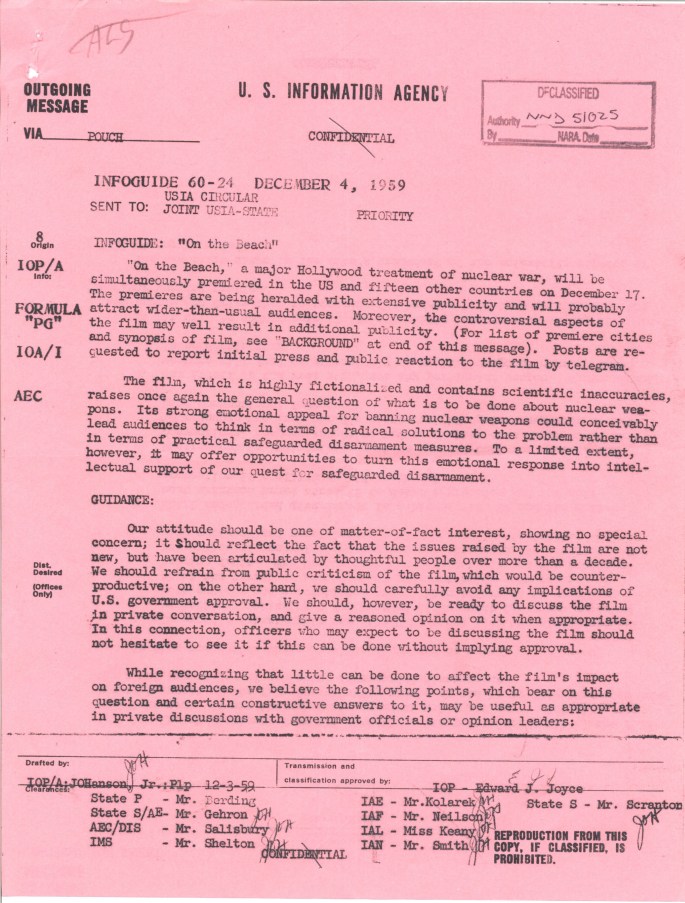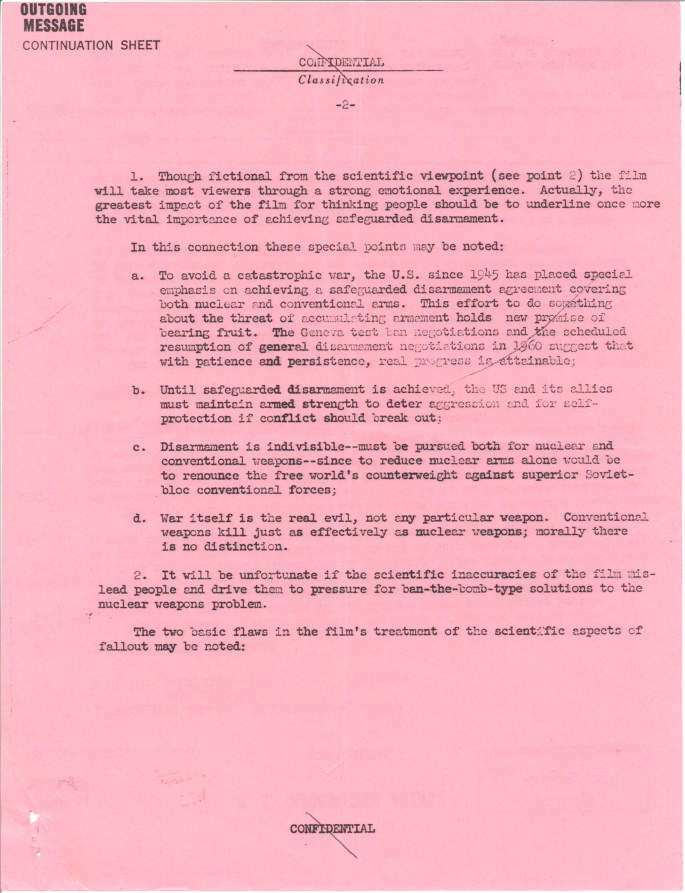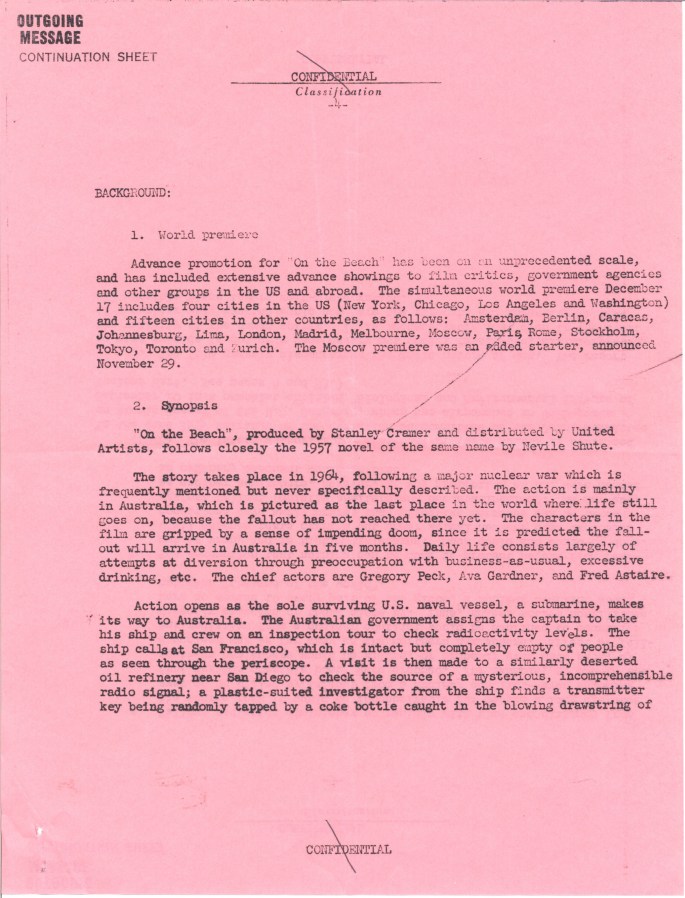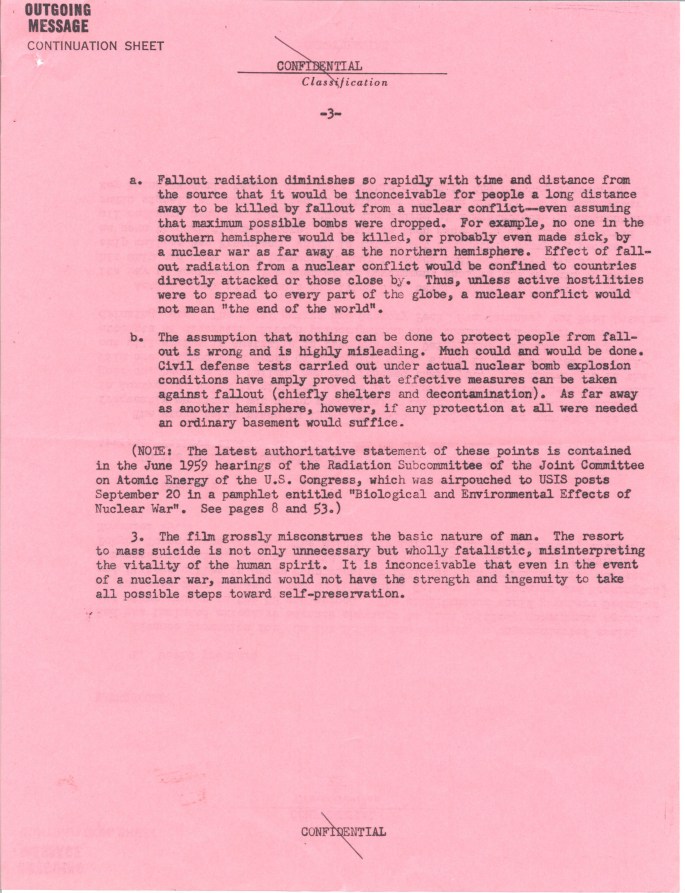カルチャー>放射能
SFの意味でのリアリティはあるが、テクニカルには多くの点で間違っているNevil Shute Nroway(ネヴィル・シュート)の1957年の小説「On the Beach (渚にて)」は、神話であって事実ではない。しかし、神話は、誰もが理解できる言葉で、核戦争は死を意味するのだと、世界に向けた述べた。そして、世界はその言葉を聞いた。
SFの意味でのリアリティはあるが、テクニカルには多くの点で間違っているNevil Shute Nroway(ネヴィル・シュート)の1957年の小説「On the Beach (渚にて)」は、神話であって事実ではない。しかし、神話は、誰もが理解できる言葉で、核戦争は死を意味するのだと、世界に向けた述べた。そして、世界はその言葉を聞いた。
In 1957, only two years before his death, the novelist Nevil Shute Norway published On the Beach, a description of mankind wiped out by radiological warfare. Norway's poignant translation of apocalyptic disaster into the everyday voices of real people caught the imagination of the world. His book became an international best-seller and was made into a successful film. The book and the film created an enduring myth, a myth which entered consciously or subconsciously into all subsequent thinking about nuclear war. The myth pictures nuclear war as silent inexorable death from which there is no escape, radioactive cobalt sweeping slowly down the sky from the northern to the southern hemisphere. The people in Australia, after the rest of the world is dead, live out their lives quietly and bravely to the end. There is no hope of survival; there is no talk of building an underground Noah's Ark to keep earth's creatures alive until the cobalt should have decayed. Twenty-five years before Jonathan Schell, Nevil Shute imagined the human species calmly acquiescing in its own extinction.自分自身も効果を疑いながら、何をしていいのかわからないまま、兵器の増強と、民間防衛演習オペレーションアラートを推進していたアイゼンハウアー政権にとって、「核戦争は死を意味する」映画は当然のことながら、懸念事項となった。
The myth of On the Beach, like Jonathan Schell's myth, is technically flawed in many ways. Almost all the details are wrong: radioactive cobalt would not substantially increase the lethality of large hydrogen bombs; fallout would not descend uniformly over large areas but would fall sporadically in space and time; people could protect themselves from the radioactivity by sheltering under a few feet of dirt; and the war is supposed to happen in 1961, too soon for even the most malevolent country to have acquired the megaton-nage needed to give a lethal dose of radiation to the entire earth. Nevertheless, the myth did what Norway intended it to do. On the fundamental human level, in spite of all the technical inaccuracies, it spoke truth. It told the world, in language that everyone could understand, that nuclear war means death. And the world listened.
If the hydrogen bomb had led to an arms race of the kind which Conant and Oppenheimer most feared, with undeliverable bombs growing bigger and bigger until they became gigaton mines, then the scenario of On the Beach might ultimately have come close to reality. Gigaton mines could, one way or another, make our planet uninhabitable. This is the truth which Norway's story brought home to mankind. And it is a truth which we must never forget.
1957年、小説家ネヴィル・シュートは死のわずか2年前に、放射能戦争によって人類が滅亡する物語である「渚にて」を出版した。ネヴィル・シュートは、黙示録の災厄を、現実の人々の日常的な声として記述したことで、世界中の想像力をつかんだ。彼の本は世界的ベストセラーとなり、成功した映画となった。この本と映画は、その後の核戦争についての思考の中に、意識的または潜在意識的に入り込む不朽の神話を生み出した。神話は核戦争を、北半球からゆっくりと空を南半球へと南下する、逃れようのない放射性コバルトによる、静かに止めようのない死として描いた。オーストラリアの人々は、そこ以外の世界の人々が死に絶えた後、終焉まで、平穏かつ勇敢に生きる。生存の望みはない。コバルトが減衰するまで、地球の生物を守る、地下のノアの箱舟を建設しようと話はない。Jonathan Schellの25年前に、ネヴィル・シュートは、人類が穏やかに滅亡の運命に従う光景を描いた。
「渚にて」の神話は、Jonathan chellの神話と同じく、多くの点でテクニカルな誤りがある。ほとんどすべての詳細が間違っている。放射性コバルトは大きな水素爆弾の致死率を実質的に増加させないだろう。放射性降下物は広い地域に渡って一様に降るのではなく、空間的にも時間的にも散発的に降ってくる。人々は数フィートの泥の下に避難することによって放射能から身を守ることができる。そして、1961年に戦争が起きると予想されている。最も悪意を持った国でさえ、地球全体に致命的な量の放射線を照射するのに必要なメガトン数を手に入れるには早すぎる。しかし、神話は、ネヴィル・シュートの意図した通りの役割を果たした。テクニカルな不正確さにもかかわらず、神話は基本的な人間のレベルでは、真実を語った。神話は、誰もが理解できる言葉で、核戦争は死を意味するのだと、世界に向けた述べた。そして、世界はその言葉を聞いた。
水素爆弾がConantとOppenheimerが最も恐れていた種類の軍拡競争をもたらし、ギガトン地雷になるまで、投擲不可能な爆弾がどんどん大きくなっていけば、「渚にて」のシナリオは最終的に現実に近づいたかもしれない。ギガトン地雷は、いずれにせよ、我々の惑星を居住不可能なものにする。これがネヴィル・シュートの物語が人類にもたらした真実である。そしてそれは我々決して忘れてはならない真実である。
[ Dyson, F., Weapons and Hope, 1984, pp.33-34]
In 1957, Nevil Shute's On the Beach took readers to a dying world, as radiation from a war in the Northern Hemisphere drifted southward and slowly killed the globe's last human inhabitants in Australia. A lone U.S. submarine represented all that was left of America, now a wasteland strewn with death. The sub's crew joined Australians in confronting death—whether their chosen ending came on a racetrack, careening wildly around untenable curves, or at home with the aid of government-issued suicide pills. Two years after the novel's release, a movie based on it offered the planet's epitaph: "The war started when people accepted the idiotic principle that peace could be maintained by arranging to defend themselves with weapons they couldn't possibly use without committing suicide. . . . The devices outgrew us. We couldn't control them."[118] The film distressed the Eisenhower administration. At a cabinet meeting, Special Assistant to the President Karl G. Han Jr. urged officials to avoid support for its "erroneous themes," such as the idea that a nuclear war in the Northern Hemisphere might create fallout sufficient to kill humans in the Southern Hemisphere.[119] The United States Information Agency produced an "Infoguide," classified until 1994, which urged officials to reassure constituents that nuclear war would never wipe out the planet's entire population.[120] An Office of Defense and Civilian Mo-bilization official warned, too, that On the Beach's theme of hopelessness might deter civil defense efforts.[121]国務省と広報文化交流局によるこの映画の分析でも、軍縮に関する過激な解決策へ人々を導くものだと警告している。
1957年、ネヴィル・シュートの「渚にて」は「戦争の放射能が北半球から南半球へと流れていき、オーストラリアにいる地球最後の人類が、ゆっくりと死にゆく」世界へと読者たちを誘った。孤独なアメリカの潜水艦が、いまや死に絶えた荒野となったアメリカを代表するものとなった。潜水艦の乗組員たちはオーストラリア人たちに合流し、レース場で猛スピードで避けきれないカーブで死を迎えるのか、政府が配布する自殺ピルの助けを借りて家で死を迎えるのか、という状況に直面することとなった。小説の発売から2年後、小説を基にした映画が、「人々が自殺せずには使用できない武器で身を守ることによって平和を維持できるという愚かな原理を人々が受け入れたとき、戦争が始まった。それは我々を圧倒した。我々は制御できなかった。」[118]という地球の墓碑銘を刻んだ。この映画は、アイゼンハウアー政権を悩ませた。閣僚会議で、Karl G. Han Jr.大統領補佐官は「北半球の核戦争で、南半球の人類を滅ぼせるだけの放射性降下物が生成されるといった『誤ったテーマ』の支持を避ける」ように当局に求めた。[119] アメリカ合衆国広報文化交流局は(1994年まで機密にされていた)「インフォガイド」を制作し、「核戦争が地球の全人類を滅亡させることは決してないと、関係者を暗視させる」よう、当局に促した。[120] 国防総省や民間防衛関係者も、「渚にて」の絶望的なテーマは市民の防衛努力を妨げるかもしれないと警告した。[121]
[118] On the Beach
[119] Papers of the President of the United States (Ann Whitman File), Cabinet Series, Box Is, 12/11/59 Folder, DDEL.
[120] For the Eisenhower administration's position on the possibility of a doomsday machine, see "Infoguide: On the Beach," United States Information Agency, 4 Dec. 1959, 1-3, White House Office, Cabinet Secretariat: Records, 1953-60, Box 22, CP 64, DDEL. In 1961, analyst Herman Kahn told a House panel that creation of a doomsday machine capable of killing mankind probably would occur by 1971. See "Civil Defense-1961," Hearing of the House of Representatives, Subcommittee on Military Operations, Committee on Gov-ernment Operations, 7 Aug. 1961, Congressional Record, 167.
[121] "Minutes of Cabinet Meeting," II Dec. 1959, 2, Cabinet Series, Box 15, Cabinet Meeting of December II, 1959, Folder, DDEL. 122. Burdick and Wheeler, Fail-Safe, 98. 123. United Press International Dispatch, 7 Apr. 1958, White House Office, Office of the Staff Secretary, Subject Series, Department of Defense, Box 1, Vol. II (6) Folder, DDEL.
[ Alice L. George: "Awaiting Armageddon: How Americans Faced the Cuban Missile Crisis", UNC Press Books, Jul 21, 2004, p.38 ]
The Eisenhower Administration was especially concerned about On the Beach. In December 1959 civil-defense director Leo Hoegh criticized it at a Cabinet meeting as "very harmful because it produced a feeling of utter hopelessness, thus undermining OCDM's [Office of Civil and Defense Management] efforts to encourage preparedness?' An analysis of the film by the State Department and the U.S. Information Agency warned that its "strong emotional appeal for banning nuclear weapons could conceivably lead au-diences to think in terms of radical solutions . . . rather than . . . practical safeguarded disarmament measures." In-sisting that the film's ending, in which the doomed Australians choose suicide in preference to death from radioactivity, "grossly misconstrues the basic nature of man;' this analysis declared: "It is inconceivable that even in the event of a nuclear war, mankind would not have the strength and ingenuity to take all possible steps toward self-preservation?'「インフォガイド」は以下のようなもので、科学的誤りが多いことを指摘しつつ...
アイゼンハウアー政権は特に「渚にて」を懸念していた。1959年12月、民間防衛局長のLeo Hoeghは、閣僚会議で「それは全くの絶望感を生み出しており、民間防衛管理局の準備促進の努力を損なうものであり、非常に有害だ」と批判した。国務省と広報文化交流局によるこの映画の分析は、「核兵器禁止に対する強い感情的な訴えは、人々を思考を、実践的な安全な軍縮手段ではなく、過激な解決策の観点から考えるように導く可能性がある。」と警告した。運命的なオーストリア人が放射能による死よりも自殺を選択するという映画の結末は「人間の基本的性質を大きく誤解している」と述べた。 この分析は次のように明言している:「核戦争が起こったとしても、人類が自己保存に向けてあらゆる可能な一歩を踏み出すための強さと才能を持っていないことは考えられないだろうか?」
[ Paul Boyer: "From activism to apathy; "America and the nuclear issue, 1963-1980" in Bulletin of the Atomic Scientists Aug 1984, p.15]
Our attitute should be one of matter-of-fact interest, showing no special concern; it should reflect the fact that the issues raised by the film are not new, but have been articulated by thoughtful people over more than a decade. We should refrain from public ciriticism of the film, which would be counterproductive; on the other hand, we should carefully avoid any implications of US government approval. We should, however, be ready to discuss the film in private conversation, and give a reasoned opinion on it where appropriate. In this connection, officers who may expect to be discussing the film should not hesitate to see it if this can be done without implying approval.
我々の態度は、特に関心を持つことがないように見せつつ、事実上の関心事とすべきものである。それは、映画によって提起された問題が新しいものではなく、10年以上にわたって思慮深い人々によって明確にされてきという事実を反映するべきである。我wレは、映画への表立った批判は控えるべきである。それは非生産である。一方、慎重に、米国政府がお墨付きを与えているように見られるのを避けるべきである。しかし、我々は日常会話では映画を論じられるようにしておくべきで、お墨付きを与えないようにしつつ、映画を論じることをためらうべきではない。





[ Preparing for the release of “On the Beach” on National Archives]


コメントをかく